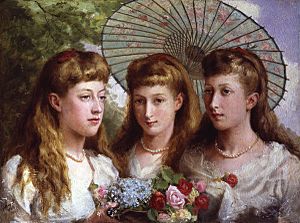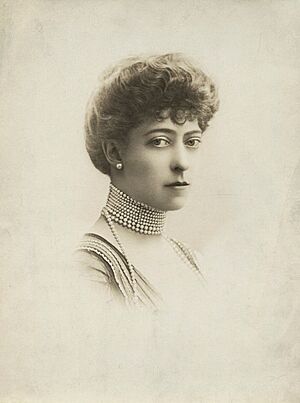Princess Victoria of the United Kingdom facts for kids
Quick facts for kids Princess Victoria |
|||||
|---|---|---|---|---|---|

Princess Victoria, c. 1890
|
|||||
| Born | Princess Victoria of Wales 6 July 1868 Marlborough House, London, England |
||||
| Died | 3 December 1935 (aged 67) Coppins, Iver, Buckinghamshire, England |
||||
| Burial | 7 December 1935 St George's Chapel, Windsor Castle; 8 January 1936 Royal Burial Ground, Frogmore |
||||
|
|||||
| House | Windsor (from 1917) Saxe-Coburg and Gotha (until 1917) |
||||
| Father | Edward VII | ||||
| Mother | Alexandra of Denmark | ||||
| Signature | |||||
Princess Victoria (Victoria Alexandra Olga Mary; born July 6, 1868 – died December 3, 1935) was a British princess. She was the fourth child and second daughter of King Edward VII and Queen Alexandra. She was also the younger sister of King George V.
Contents
Early Life and Family
Princess Victoria was born on July 6, 1868, at Marlborough House in London. Her full name was Victoria Alexandra Olga Mary. Her father was Albert Edward, Prince of Wales, who later became King Edward VII. Her mother was Alexandra, Princess of Wales, who later became Queen Alexandra.
Victoria's grandparents were Queen Victoria and Prince Albert. Her mother's parents were King Christian IX and Queen Louise of Denmark. Close family members often called Princess Victoria "Toria." From birth, she was known as Her Royal Highness Princess Victoria of Wales. This title showed she was a granddaughter of the British monarch.
Princess Victoria was baptized at Marlborough House on August 6, 1868. The ceremony was performed by Archibald Campbell Tait, who was the Bishop of London.
Growing Up and Hobbies
Princess Victoria was educated at home with her sisters. She grew up at Marlborough House and Sandringham. Tutors taught her lessons. Sometimes, she spent summers in Denmark, which was her mother's home country.
People described Victoria as a "lively, mischievous girl" when she was young. She was smart, tall, and elegant. She had a great sense of humor and was a good friend. She had large, expressive blue eyes. She was known for being genuine and not acting like she was better than others because of her royal position.
Victoria loved many activities. She enjoyed horse riding, cycling, reading, listening to music, and dancing. Her special hobby was photography. She put together several albums of family photos. Her pictures were even shown in different exhibitions.
She also loved animals very much. Her favorite dogs were named Sam, Mas, and Punchy. For six years, she had a pet pigeon. She would carry it with her in a small basket when she went for walks or traveled.
Relationships and Marriage Proposals
Princess Victoria stayed good friends with her cousins in Russia and Greece. Nicholas II, who later became the Emperor of Russia, was her first cousin. He was the same age as her. When they were young, he was in love with her. Nicholas liked Victoria because she was serious, thoughtful, and had a "non-feminine mind."
In 1889, Nicholas described Victoria to his friend, Grand Duke Alexander Mikhailovich. He said, "She is a truly wonderful creature." He added that the more you got to know her, the more you saw her good qualities. He found it hard to understand her views at first, but this challenge made her even more charming to him. Grand Duke Alexander Mikhailovich was also interested in Victoria. Later, Grand Duke Michael Alexandrovich was also fascinated by her.
Another person who wanted to marry Victoria was her cousin, Crown Prince Christian of Denmark. He later became Christian X. However, Princess Victoria said no to him. This made her parents quite disappointed.
The Portuguese king Carlos I also wanted to marry her. But he asked Victoria to become Catholic. Her parents did not agree with this. The 5th Earl of Rosebery also tried to get her attention, but he was not successful.
Princess Victoria never married. It is said that her mother supported her decision to remain single.
Victoria was very close to her parents. When she appeared in public, it was usually with them. This was common for unmarried royal women at the time. She went with her parents to official events and helped them in their private lives. Her cousin, Grand Duchess Olga Alexandrovna of Russia, later felt sorry for Victoria. She thought Victoria seemed like "a glorified maid to her mother." Olga believed this was why Victoria never married, as she didn't want to go against her mother. Olga said, "I'd something of a rebel in me. Toria had not."
Victoria was closest to her older brother, George. He became king and emperor in 1910. They had a warm relationship throughout their lives. They had similar personalities and a shared sense of humor. When Victoria died in 1935, King George said, "How I will miss our daily phone calls. Nobody had such a sister as I had." The king died just one month after his sister. However, Victoria was not close to George's wife, Queen Mary. Victoria once called Queen Mary "terribly boring." This was likely because they had different personalities, upbringings, and interests.
Later Years and Passing
In March 1905, Princess Victoria visited Portugal. She traveled with her mother, Queen Alexandra, her sister Maud (who would become Queen Maud of Norway), and her brother-in-law Carl (who would become King Haakon VII of Norway). They traveled on the royal yacht HMY Victoria and Albert.
On the first day, Victoria stayed on the yacht because she was not feeling well. Queen Alexandra, Princess Maud, and Prince Carl met with the Portuguese Queen Amelia and Queen Dowager Maria Pia. The next day, Victoria, with her sister, visited the Portuguese king, queen, and their sons. On March 24, the British guests returned home.
After her father, King Edward VII, died in 1910, Victoria remained close to her mother. Queen Alexandra was often sad and had trouble hearing. Victoria went with her mother to different events and on holidays. Once, when the Queen Mother could not attend a charity event, she sent her daughters Louise and Victoria. Victoria wrote in her diary that it was "terrible to be there without dear Mama."
During World War I, there was strong public anger towards Germany. Because of this, King George V decided to give up all German titles and honors. He asked other members of the royal family to do the same. The king changed the name of the royal family from Saxe-Coburg and Gotha to Windsor. He named it after his favorite castle. Princess Victoria also changed her surname to Windsor.
After her mother, Queen Alexandra, died in 1925, Victoria moved to Coppins. This was a house in the village of Iver, Buckinghamshire. She lived there until she passed away. In her last years, Victoria enjoyed listening to music, gardening, and helping with local community issues.
Victoria supported a young cellist named Beatrice Harrison and her sisters, May and Margaret, who also studied music. She even paid for Harrison's valuable Guarneri cello. Victoria often invited the Harrison sisters to her home and to Sandringham. She also went to their concerts at the Wigmore Hall. In 1928, she asked HMV to make some private recordings for her. These recordings captured Victoria playing the piano while Beatrice Harrison played the cello and May Harrison played the violin. These recordings were later released to the public.
Victoria also had other friends. These included members of the Musgrave family, the widowed 5th Earl of Rosebery, and Violet Vivian. Violet Vivian used to be a lady-in-waiting to Queen Alexandra. Lady Musgrave was Victoria's lifelong friend and lady-in-waiting. The princess helped Violet Vivian design the Cestyll Garden near the village of Cemaes in Anglesey.
Princess Victoria passed away in the early morning of December 3, 1935. She was 67 years old and died at her home. She had been unwell for about a month. Her health worsened with a severe bleed on December 1. The State Opening of Parliament, planned for December 3, was canceled because of her death. Instead, the King's Speech was read to Parliament without a ceremony.
Her funeral was held on December 7, 1935, at St George's Chapel at Windsor Castle. She was first buried there. Her brother, King George V, was among those mourning at the funeral. King George was also not in good health. His doctor wanted the funeral service to be shorter. However, it was not shortened. Some later believed that the long service contributed to George's health getting worse, and he died soon after.
Victoria's remains were later moved. She was reburied at the Royal Burial Ground, Frogmore, in Windsor Great Park, on January 8, 1936. Her will was made public in London in 1936. Her estate was worth about £237,455. This would be about £11.7 million in 2022, when adjusted for inflation.
Titles and Honors
Titles and Styles
- July 6, 1868 – January 22, 1901: Her Royal Highness Princess Victoria of Wales
- January 22, 1901 – December 3, 1935: Her Royal Highness The Princess Victoria
Honors
Princess Victoria received several special honors during her life:
- Imperial Order of the Crown of India, given on August 6, 1887.
- Dame Grand Cross of the Order of the Hospital of St. John of Jerusalem.
- Member First Class of the Royal Order of Victoria and Albert.
- Royal Family Order of King Edward VII.
- Royal Family Order of King George V.
Images for kids
-
Princess Victoria's coat of arms until 1917
See also
 In Spanish: Victoria del Reino Unido (1868-1935) para niños
In Spanish: Victoria del Reino Unido (1868-1935) para niños





